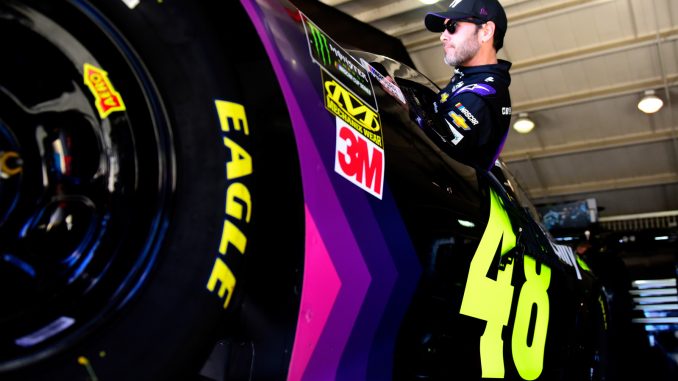
With NASCAR announcing the enforcement of pit road speed limits during qualifying, a couple of things are certain: pit road will be safer and less chaotic, and strategies will become more complicated.
For one thing, drivers won’t be able to hustle down pit road to slot into a specific “hole” between cars trying to post qualifying laps. The new policy also is likely to discourage drivers from waiting until the absolute last moment to make a run.
Precise communication between drivers and spotters may be at an even bigger premium than it already is.
“It’s a logical rule change,” seven-time Monster Energy NASCAR Cup Series champion Jimmie Johnson said Friday morning at Auto Club Speedway, site of Sunday’s Auto Club 400 (3:30 p.m. ET on FOX, MRN and SiriusXM NASCAR Radio).
“It’s just kind of weird timing in my opinion. We’re packing our bags and getting ready to head to Fontana and we’re five races into the year and the rule comes. I’m like what? Why didn’t we start the year like this? Again, it’s a logical rule.”
And Johnson already has come up with a solution to potential speeding when he’s trying to work the No. 48 Chevrolet into an advantageous qualifying position on the track.
“It’s just going to be silly if you’re at the end of pit road trying to get into a hole, and your time isn’t going to count because you went over the speed limit,” Johnson said. “I think the way I’m going to prevent doing that is I‘m going to go down past the last orange line (at the end of pit road) and sit.
“Well, at Martinsville, you’re sitting on the race track. At different tracks, that line is at a different spot. Understanding the intentions of this rule is going to be beneficial for everybody, and we can adjust to it.”
Johnson says he’ll also have to change his mind-set, because there are clear reasons to try to push the speed limit on pit road during qualifying.
“In most circumstances, the spotters are trying to put us into holes on the track, and you don’t want to impede somebody that’s on a run,” Johnson said. “So spotters have visual marks, the drivers are used to seeing something in the mirror, and when they’re told which car to follow, we start rolling off of pit road and try to get up to speed to fill that gap.
“The other piece to it is that we need every foot of race track to get these cars up to speed to do our qualifying in one lap. So, if you can leave pit road as hard as you can, that also helps. You have those two elements that you’re trying to play.”
Johnson is a six-time winner at Auto Club with an average finish of 7.2 at the track closest to his El Cajon, Calif., home. He earned the first of his 83 career victories at the two-mile track in 2002 and won most recently here in 2016, his record-tying seventh championship season.
In qualifying trim, Johnson was fastest in opening Cup practice on Friday, posting a top speed of 179.386 mph on the first of his five laps in the session.
- Spire Motorsports confirms split with Corey LaJoie - July 25, 2024
- Kyle Larson wins NASCAR Brickyard 400 after overtime chaos - July 21, 2024
- Photos: NASCAR at the Brickyard Sunday July 21, 2024 - July 21, 2024